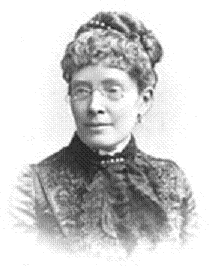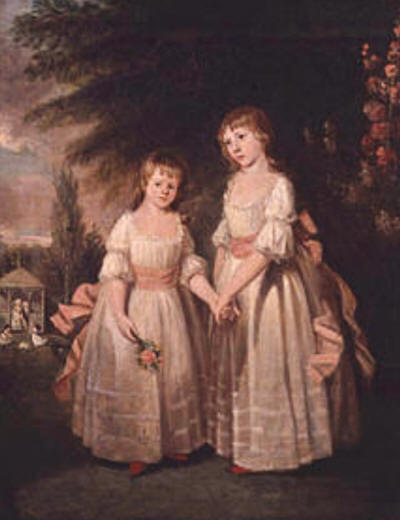

Queer Places:
Nottingham General Cemetery
Nottingham, Nottingham Unitary Authority, Nottinghamshire, England
 Ann Taylor
Gilbert (30 January 1782 – 20 December 1866) was an English poet and literary critic. She gained long-lasting popularity in her youth as a writer of verse for children. In the years immediately before her marriage, she became an astringent literary critic. However, she is best remembered as the elder sister and collaborator of
Jane Taylor. At the other extreme of
the life cycle, the seventy-one-year-old Ann Gilbert, who cowrote the poem now
known as “Twinkle, Twinkle, Little Star" with her sister, appreciatively described “the latter
years of . . . friendship” with her friend Mrs. Mackintosh as “the gathering
of the last ripe figs, here and there, one on the topmost bough!” Gilbert used
similar imagery in an 1861 poem she sent to another woman celebrating the
endurance of a friendship begun in childhood: “As rose leaves in a china Jar /
Breathe still of blooming seasons past, / E’en so, old women as they are /
Still doth the young affection last.” Gilbert’s metaphors, drawn from the
language of flowers and the repertoire of romantic poetry, asserted that
friendship between women was as vital and fertile as the biological
reproduction and female sexuality to which figures of fruitfulness commonly
alluded. Ann Gilbert, a paragon of domesticity, wrote of reaching
“blood-heat-fever-heat on the thermometer of friendship” with a neighbor girl,
but nothing in her lengthy autobiography suggests that the relationship went
beyond the “amitié” that Anna Jameson distinguished from “amour” in an 1836
letter to Ottilie von Goethe. Gilbert recalled how as a girl, her sister
became “by instantaneous attraction” another girl’s “bosom friend”. Gilbert described the first of a series of annual summer trips she took with
her friend Mary as a “honeymoon of delight”. Ann Gilbert’s lifelong friendship
with Anna Forbes was an “intimacy begun in the glow of young extravagance,”
then “strengthened . . . matured [and] rivetted by the enduring connection
that linked a daughter of hers with a son of mine”. Gilbert, then
Taylor, wrote to her recently married friend Anna Forbes Laurie about every
stage of the Reverend Gilbert’s courtship, and informed Laurie immediately
after accepting his proposal, recalling that her friend had helped persuade
her to say yes: “I am learning with tolerable facility to believe what you
told me when you said, ‘Oh, this delightful, mutual love’”.
Ann Taylor
Gilbert (30 January 1782 – 20 December 1866) was an English poet and literary critic. She gained long-lasting popularity in her youth as a writer of verse for children. In the years immediately before her marriage, she became an astringent literary critic. However, she is best remembered as the elder sister and collaborator of
Jane Taylor. At the other extreme of
the life cycle, the seventy-one-year-old Ann Gilbert, who cowrote the poem now
known as “Twinkle, Twinkle, Little Star" with her sister, appreciatively described “the latter
years of . . . friendship” with her friend Mrs. Mackintosh as “the gathering
of the last ripe figs, here and there, one on the topmost bough!” Gilbert used
similar imagery in an 1861 poem she sent to another woman celebrating the
endurance of a friendship begun in childhood: “As rose leaves in a china Jar /
Breathe still of blooming seasons past, / E’en so, old women as they are /
Still doth the young affection last.” Gilbert’s metaphors, drawn from the
language of flowers and the repertoire of romantic poetry, asserted that
friendship between women was as vital and fertile as the biological
reproduction and female sexuality to which figures of fruitfulness commonly
alluded. Ann Gilbert, a paragon of domesticity, wrote of reaching
“blood-heat-fever-heat on the thermometer of friendship” with a neighbor girl,
but nothing in her lengthy autobiography suggests that the relationship went
beyond the “amitié” that Anna Jameson distinguished from “amour” in an 1836
letter to Ottilie von Goethe. Gilbert recalled how as a girl, her sister
became “by instantaneous attraction” another girl’s “bosom friend”. Gilbert described the first of a series of annual summer trips she took with
her friend Mary as a “honeymoon of delight”. Ann Gilbert’s lifelong friendship
with Anna Forbes was an “intimacy begun in the glow of young extravagance,”
then “strengthened . . . matured [and] rivetted by the enduring connection
that linked a daughter of hers with a son of mine”. Gilbert, then
Taylor, wrote to her recently married friend Anna Forbes Laurie about every
stage of the Reverend Gilbert’s courtship, and informed Laurie immediately
after accepting his proposal, recalling that her friend had helped persuade
her to say yes: “I am learning with tolerable facility to believe what you
told me when you said, ‘Oh, this delightful, mutual love’”.

Jane and Ann by their father, Isaac Taylor
The Taylor sisters were part of an extensive literary family, daughters of the engraver Isaac Taylor and the writer Ann Taylor.[1] Ann was born in Islington and lived with her family at first in London and later in Lavenham, Suffolk, in Colchester, and briefly in Ongar. The sisters' father, Isaac Taylor, and her grandfather were engravers. Her father later became an educational pioneer and Independent minister and wrote a number of instructional books for the young. Their mother, Ann Martin Taylor (1757–1830) wrote seven works of moral and religious advice – in many respects liberal for their time – two of them fictionalized. Isaac, brother of Ann and Jane, wrote as a theologian, but also as the inventor of a patent beer tap. Their elder brother Charles Taylor edited The Literary Panorama, for which he wrote on topics from art to politics, and produced anonymously a massive annotated translation of Augustin Calmet's Dictionary of the Bible. Their youngest brother Josiah was a publisher, chiefly of works on architecture and design.
The sisters and their authorship of various works have often been confused, usually to Jane's advantage. This is in part because their early works for children were published together and without attribution, but also because Jane, by dying young at the height of her powers, unwittingly attracted early posthumous eulogies, including what is almost a hagiography by her brother Isaac, and much of Ann's work came to be ascribed to Jane, a borrowing which, Ann ruefully remarked, she could ill afford and which Jane certainly did not require. It is true that Jane achieved much more than Ann as a writer of poetry for an adult readership – though Ann's poem "The Maniac's Song", published in the Associate Minstrels (1810), was probably the finest short poem by either sister, and it has been postulated as an inspiration for Keats's La Belle Dame sans Merci.[2] However, Ann Taylor also deserves remembering as a writer of prose, particularly for her autobiography and the many letters of hers that survive. Her style is strong and vivid, and when she was not too preoccupied with moral and religious themes, she tended, like her sister Jane, to pessimism about her own spiritual worth – it is often shot through with a pleasing and sometimes acerbic wit. The autobiography also provides detailed information on the life of what was a moderately prosperous dissenting family in the late 18th and early 19th centuries.
On 24 December 1813, Ann married Joseph Gilbert, an Independent (later Congregational) minister and theologian, and left Ongar for a new home far from her family, at Masborough near Rotherham. A widower of 33, Gilbert had proposed to Ann before he even met her, forming a sound estimate of her character and intelligence from her writings, particularly as a trenchant critic in The Eclectic Review. Gilbert was at the time of their marriage the classics tutor at Rotherham Independent College – the nearest body to a university open to Dissenters at that time – and simultaneously pastor of the Nether Chapel in Sheffield. In 1817, he moved to the pastorate of the Fish Street Chapel in Hull, and then in 1825 to Nottingham, serving in chapels there for the rest of his life. While busy with the duties of wife and later mother, Ann Gilbert managed to write further poems, hymns, essays and letters. Her interest in public matters such as atheism, prison reform and the anti-slavery movement often spurred her, and the results found a way into print. Oddly for one of independence of mind and strongly held, usually liberal opinions, she was firmly opposed to female suffrage. After Gilbert died on 12 December 1852, Ann wrote a memoir of him.[9] Nor did she spend the rest of her long life in retirement. While actively supporting the members of her large family through visits and a stream of letters – family was always of central concern to the Taylors – she travelled widely in Britain, taking in her stride as an old lady travelling conditions that might have daunted one much younger. She died on 20 December 1866 and was buried next to her husband in Nottingham General Cemetery, although the inscription recording this on the vast Gothic sarcophagus has disappeared.
My published books: